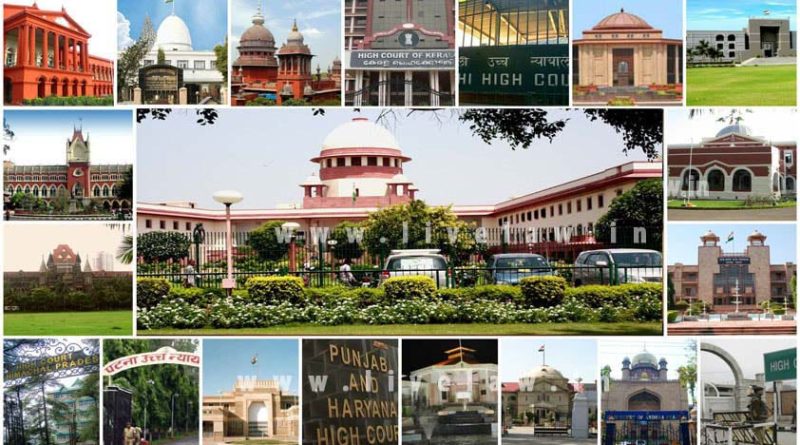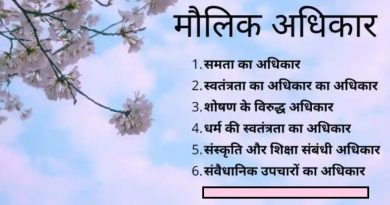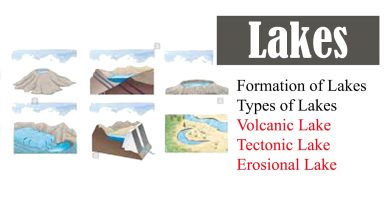High Courts of India : Jurisdiction, Composition, apointments, judges cases ( UPSC )
The highest judicial court in a state is the High Court. It is termed as the second-highest in the country after the Supreme Court of India. Currently, India has 25 High Courts established in different states of the country. As a vital part of the Indian Judiciary, High Court becomes an important topic with reference to the candidates preparing for the UPSC exam.

Which is the Newest High Court of India?
Andhra Pradesh is the recent state to have the High Court. High Court was established in Andhra Pradesh on 1st January 2019.
Constitution of High Court – Under British rule, each High Court has a Chief Justice and maximum 15 other puisne judges. But later certain changes were brought about in the composition of the High Court in India:
- Every High Court shall have a Chief Justice appointed by the President
- Unlike before, there was no fixed number of Judges who could be appointed for each High Court
- Additional Judges can also be appointed for the clearance of cases pending in the court. But their tenure cannot exceed more than two years
One thing that must be noted is that no one above the age of 62 years can be appointed as a High Court Judge. There is no uniformity among the High Courts regarding the number of Judges they will have. A smaller state shall have less number of judges in comparison to a larger state.
High Court Jurisdiction
The High Court is the highest court of appeal in the state vested with the power to interpret the Constitution. It is the protector of the Fundamental Rights of the citizens. Besides, it has supervisory and consultative roles. However, the Constitution does not contain detailed provisions with regard to the jurisdiction and powers of a high court.
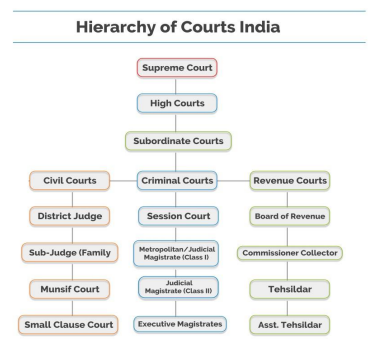
At present, the following jurisdictions are enjoyed by a High Court-
- Original jurisdiction
- Writ jurisdiction
- Appellate jurisdiction
- Supervisory jurisdiction
- Control over subordinate courts
- A court of record
- Power of judicial review
The Jurisdiction of Highcourt are as mentioned below –
- Original Jurisdiction – In such kind of cases the applicant can directly go to the High Court and does not require to raise an appeal. It is mostly applicable for cases related to the State Legislative Assembly, marriages, enforcement of fundamental rights and transfer cases from other courts.
- Power of Superintendence – It a special power enjoyed only by High Court and no other subordinate court has this power of superintendence. Under this, the High Court holds the right to order its subordinate offices and courts the way of maintaining records, prescribe rules for holding proceedings in the court and also settle the fees paid to sheriff clerks, officers and legal practitioners.
- Court of Record – It involves recording the judgments, proceedings and acts of high courts for perpetual memory. These records cannot be further questioned in any court. It has the power to punish for contempt of itself.
- Control over Subordinate Courts – This is an extension of the supervisory and appellate jurisdiction. It states that the High Court can withdraw a case pending before any subordinate court if it involves the substantial question of law. The case can be disposed of itself or solve the question of law and return back to the same court.
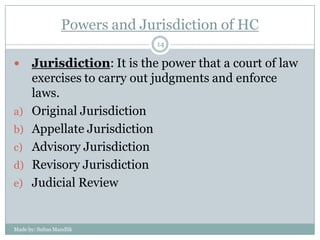
- Appellate Jurisdiction – This is for cases where people have risen a complaint about a review of the judgement given by the district level or subordinate court of that territory. This power is further divided into two categories:
- Civil Jurisdiction – this includes orders and judgements of the district court, civil district court and subordinate court
- Criminal Jurisdiction – this includes judgements and orders of the sessions court and additional sessions court.
- Power of Judicial Review – This power of High Court includes the power to examine the constitutionality of legislative and executive orders of both central and state government. It is to be noted that the word judicial review is nowhere mentioned in our constitution but the Article 13 and 226 explicitly provide High Court with this power.
- Writ Jurisdiction of High Court – Article 226 of the Constitution empowers a high court to issue writs including habeas corpus, mandamus, certiorari, prohibition, and quo warrento for the enforcement of the fundamental rights of the citizens and for any other purpose. Read in detail about the following –
- Habeas Corpus
- Writ of Mandamus

- The phrase ‘for any other purpose’ refers to the enforcement of an ordinary legal right. The high court can issue writs to any person, authority and government not only within its territorial jurisdiction but also outside its territorial jurisdiction if the cause of action arises within its territorial jurisdiction (15th Constitutional Amendment Act of 1963).
- In the Chandra Kumar case (1997), the Supreme Court ruled that the writ jurisdiction of both the high court and the Supreme Court constitute a part of the basic structure of the Constitution. Hence, it cannot be ousted or excluded even by way of an amendment to the Constitution.
- In Shah Faesal’s Case, his case is justified because the cause of action happened in Delhi and then he was taken to outside the territory of Delhi.
How is a High Court Judge Appointed?
A High Court Judge is appointed by the President of India. He is solely responsible for the appointment of any judge in a High Court. However, he may consult the Governor of the State, the acting Chief Justice of India and Chief Justice of that particular state’s High Court.
A High Court judge is also liable to get transferred to other High Courts. This decision is entirely dependent on the Chief Justice of India. Transfer of judges is done with an aim to ensure proper and just trial for every case fought in the court of law.
Eligibility Criteria for High Court Judge
There are certain eligibility criteria that need to be fulfilled to be appointed as a judge in any High court in India. Given below are the set of eligibility criteria mandatory for the appointment of High Court judges:
- Any of the given qualifications must be fulfilled:
- The person should have been a Barrister for more than five years
- Has been a civil servant for over 10 years along with serving the Zila court for at least 3 years
- A person who has been a pleader for over 10 years in any High Court.
- No judge should be of more than 62 years of age
The law states that every state must have a separate High Court, however, there still are certain states that do not have an individual High Court. For example – both Punjab and Haryana come under the jurisdiction of Punjab High Court sitting at Chandigarh. Besides, there is a common High Court for seven states – Assam, Nagaland, Manipur, Tripura, Meghalaya, Arunachal Pradesh and Mizoram.
Salary and Perks of High Court Judges
There has been a massive increase in the salary paid to a High Court judge. The table below gives the salary description of a judge in the High Court:
| High Court Judge Salary | ||
| Designation | Past Salary | After Increment |
| Chief Justice of the High Court | 90,000 | 2,50,000 |
| Other Judges of the High Court | 80,000 | 2,25,000 |
Apart from the salary, there are various other perks and allowances provided to a Judge in High Court.
- Appointment of HC Judges:
- Article 217 of the Constitution: It states that the Judge of a High Court shall be appointed by the President in consultation with the Chief Justice of India (CJI), the Governor of the State.
- In the case of appointment of a Judge other than the Chief Justice, the Chief Justice of the High Court is consulted.
- Consultation Process: High Court judges are recommended by a Collegium comprising the CJI and two senior-most judges.
- The proposal, however, is initiated by the Chief Justice of the High Court concerned in consultation with two senior-most colleagues.
- The recommendation is sent to the Chief Minister, who advises the Governor to send the proposal to the Union Law Minister.
- The Chief Justice of the High Court is appointed as per the policy of having Chief Justices from outside the respective States.
- The Collegium takes the call on the elevation.
- Ad-hoc Judges: The appointment of retired judges was provided for in the Constitution under Article 224A.
- Under the Article, the Chief Justice of a High Court for any State may at any time, with the previous consent of the President, request any person who has held the office of judge of that court or of any other High Court to sit and act as a judge of the High Court for that State.
- Recently, the Supreme Court pushed for the appointment of retired judges to battle the pendency of cases in High Courts.
- It orally outlined prospective guidelines for the appointment and functioning of an ad-hoc judge.
- Article 217 of the Constitution: It states that the Judge of a High Court shall be appointed by the President in consultation with the Chief Justice of India (CJI), the Governor of the State.
- Collegium System:
- It is the system of appointment and transfer of judges that has evolved through judgments of the SC, and not by an Act of Parliament or by a provision of the Constitution.
- Evolution of the System:
- First Judges Case (1981): It declared that the “primacy” of the Chief Justice of India (CJI) recommendation on judicial appointments and transfers can be refused for “cogent reasons.”
- The ruling gave the Executive primacy over the Judiciary in judicial appointments for the next 12 years.
- Second Judges Case (1993): SC introduced the Collegium system, holding that “consultation” really meant “concurrence”.
- It added that it was not the CJI’s individual opinion, but an institutional opinion formed in consultation with the two senior-most judges in the SC.
- First Judges Case (1981): It declared that the “primacy” of the Chief Justice of India (CJI) recommendation on judicial appointments and transfers can be refused for “cogent reasons.”
- Third Judges Case (1998): SC on President’s reference expanded the Collegium to a five-member body, comprising the CJI and four of his senior-most colleagues (for example for the transfer of HC judges).
- Issues Involved:
- Cumbersome Process: There are inordinate delays in the appointment of High Court judges and depleting numbers in the higher judiciary threaten to affect the justice delivery mechanism.
- Lack of transparency: The absence of formal criteria has multiple worrying implications.
- Presently, there is no structured process to investigate if a judge who is recommended by the collegium has any conflict of interests.
- Improper Representation: The collegium system structurally tends to favour particular sections of society and is far from being representative of the population for whom it seeks to deliver justice.
- Vacancy in High Courts: The total sanctioned strength of judges across the 25 high courts is 1,098 but the working strength is only 645, a shortfall of 453 judges.
- High Pendency of Cases: The total pendency of cases in the several courts of India at different levels, sums up to a total of about 3.7 crores thus increasing the demand of a better and improved judicial system.
- Attempts of Reform:
- The attempt was made to replace the Collegium by a ‘National Judicial Appointments Commission (NJAC)’ in 2014 through the 99th Constitutional Amendment Act, 2014.
- The NJAC proposed to make the appointment of High Court and Supreme Court judges and chief justices more transparent.
- They will be selected by the commission, whose members will be drawn from the judiciary, legislature and civil society.
- The Constitutional Bench of the Supreme Court declared NJAC unconstitutional in 2015, citing that it violates the Basic Structure of the Constitution of India on the ground that it posed a threat to the independence of the judiciary.
- The attempt was made to replace the Collegium by a ‘National Judicial Appointments Commission (NJAC)’ in 2014 through the 99th Constitutional Amendment Act, 2014.
Way Forward
- It is time to think of a permanent, independent body to institutionalize the process with adequate safeguards to preserve the judiciary’s independence guaranteeing judicial primacy but not judicial exclusivity.
- It should ensure independence, reflect diversity, demonstrate professional competence and integrity.
- Instead of selecting the number of judges required against a certain number of vacancies, the collegium must provide a panel of possible names to the President to appoint in order of preference and other valid criteria.

